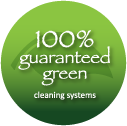Toxic Kitchen Cleaning Products to Avoid!
By Naturally Clean
While 74 per cent of Canadians name the kitchen as their top spot for cleaning, only 10 per cent of the ingredients present in common cleaners are fully tested for their health and environmental effects. In fact, an estimated 75,000 different chemical ingredients are used in common household cleaning products. One has only to read the virtually unpronounceable ingredients and cautionary notices on cleaning product labels to realize these products are extremely toxic and, in all likelihood, not good for us or the environment. Most cleaners leave residues of these toxic chemicals on countertops and dishes, exposing us and our children to unwanted substances that have the potential to cause countless health issues.
This spring cleaning season, while you purge your home from the accumulated winter gunk, dust and dirt, the Canadian Health Food Association (CHFA), recommends you read the labels of cleaning products to avoid the most common and harmful toxic chemicals present in kitchen cleaning products such as all-purpose cleaners, dishwashing soap and oven cleaners, to name few.
All-purpose cleaners contain MEA, DEA and TEA, chemicals which may form carcinogenic nitrosamines. They are also filled with fragrance chemicals that easily irritate human tissue and can cause migraines. All-purpose cleaners also contain Coal tar dyes and petrochemical derivatives which are contaminated with heavy metals thought to be implicated in cancers. Amonia is another highly toxic chemical present in all-purpose cleaners. This chemical produces highly irritant vapours that damage the skin, eyes, throats and lungs. Nonulphenol ethoxylates are also commonly present in these products. These compounds affect the endocrine system by mimicking estrogen and it is linked to reproductive problems.
Another chemical-heavy cleaning product present in most kitchens is common dishwashing soap. This product contains high levels of phosphates which damage aquatic ecosystems by promoting algal blooms which kill aquatic life. They are also full of Coal tar dyes and petrochemical derivatives which, as explained above, should be avoided. Triclosan is another culprit commonly found in dishwashing soap; this chemical is a hormone disrupter and can also irritate the eyes and skin.
Though it is always pleasant to cook delicious meals in a clean oven, oven cleaners are also packed with highly toxic chemicals such as 2-Butoxyethanol, which is linked to blood disorders and reproductive problems. Also Sodium hydroxide, a highly corrosive compound which can burn eyes, skin and lungs is a common ingredient in oven cleaners.
The best way to avoid contact with these highly toxic chemicals is to carefully read labels and opt for greener alternatives. To learn more about excellent do it to yourself recipes for natural cleaners send us an email at Naturally Clean and we will send you recipes that are non-toxic and safe as well as fun to make.




